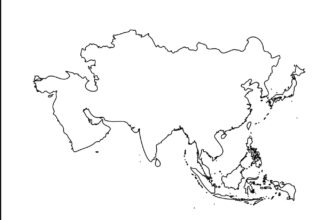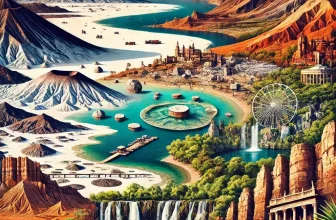India, a land of diverse cultures, landscapes, and climates, is home to some of the world’s largest and most geographically varied states. From the vast deserts of Rajasthan to the lush forests of Madhya Pradesh, the size of these states shapes their resources, economy, and way of life. In this post, we explore the largest states in India by land area, uncovering the unique geographical features, cultural significance, and economic contributions that make each of these regions stand out.
The Largest States in India by Land Area:
1. Rajasthan
- Land Area: 342,239 km²
- Percentage of Total India: 10.4%
- Capital: Jaipur
- Significance:
- Rajasthan is the largest state in India by land area. Covering more than 342,000 square kilometers, it is known for the Thar Desert, historic forts, palaces, and vibrant culture.
- The state shares borders with Pakistan and several Indian states, including Punjab, Haryana, Uttar Pradesh, Madhya Pradesh, and Gujarat.
- https://rajasthan.gov.in/
2. Madhya Pradesh
- Land Area: 308,252 km²
- Percentage of Total India: 9.4%
- Capital: Bhopal
- Significance:
- Madhya Pradesh ranks second in land area. Known for its vast forests, wildlife reserves, and historical monuments like Khajuraho and Sanchi, it is often called the “Heart of India.”
- Bhopal, the capital, is famous for its lakes and historical architecture.
- https://mp.gov.in/
3. Maharashtra
- Land Area: 307,713 km²
- Percentage of Total India: 9.3%
- Capital: Mumbai
- Significance:
- Maharashtra, the third-largest state by land area, is home to Mumbai, India’s financial capital.
- The state features a variety of landscapes, from the Konkan Coast to the Deccan Plateau, and is rich in culture, history, and industry.
- https://www.maharashtra.gov.in/
4. Uttar Pradesh
- Land Area: 240,928 km²
- Percentage of Total India: 7.3%
- Capital: Lucknow
- Significance:
- Uttar Pradesh is the most populous state in India and ranks fourth in land area.
- The state is home to iconic landmarks like the Taj Mahal and Varanasi and plays a crucial role in Indian agriculture, particularly wheat and sugarcane production.
- http://up.gov.in/
5. Gujarat
- Land Area: 196,024 km²
- Percentage of Total India: 6.0%
- Capital: Gandhinagar
- Significance:
- Gujarat is known for its diverse landscapes, including the Rann of Kutch, Gir National Park, and its long coastline along the Arabian Sea.
- It is also the birthplace of Mahatma Gandhi and has a strong industrial base, particularly in textiles, chemicals, and petrochemicals.
- https://gujaratindia.gov.in/
6. Karnataka
- Land Area: 191,791 km²
- Percentage of Total India: 5.8%
- Capital: Bengaluru
- Significance:
- Karnataka features a mix of landscapes, including the Western Ghats, Deccan Plateau, and vibrant cities like Bengaluru.
- The state is known for its rich cultural heritage, including classical music and dance forms, and is a major IT hub.
- https://www.karnataka.gov.in/english
7. Andhra Pradesh
- Land Area: 162,975 km²
- Percentage of Total India: 4.96%
- Capital: Amaravati
- Significance:
- Andhra Pradesh, located on the southeastern coast of India, features a mix of coastal plains, dense forests, and significant river systems like the Godavari and Krishna rivers.
- The state is a major producer of rice, earning it the title of the “Rice Bowl of India.”
- https://www.ap.gov.in/
8. Odisha
- Land Area: 155,707 km²
- Percentage of Total India: 4.7%
- Capital: Bhubaneswar
- Significance:
- Odisha is known for its rich cultural heritage, ancient temples, and a long coastline along the Bay of Bengal.
- The state is home to Konark Sun Temple and Chilika Lake, one of Asia’s largest brackish water lagoons.
- https://odisha.gov.in/
9. Chhattisgarh
- Land Area: 135,192 km²
- Percentage of Total India: 4.1%
- Capital: Raipur
- Significance:
- Chhattisgarh is rich in mineral resources and dense forests, and has a significant tribal population.
- The state is a leading producer of coal, iron ore, and steel. Raipur, the capital, has developed rapidly as a trade and industry hub.
- https://cgstate.gov.in/
10. Tamil Nadu
- Land Area: 130,058 km²
- Percentage of Total India: 3.96%
- Capital: Chennai
- Significance:
- Tamil Nadu is known for its ancient temples, classical dance forms, and a long coastline along the Bay of Bengal.
- The state is a major producer of textiles, automobiles, and machinery, and Chennai, the capital, is one of India’s largest cities and an economic powerhouse in the south.
- https://www.tn.gov.in/
Closing Remarks
The largest states in India by land area not only span vast geographic regions but also contribute significantly to the country’s agriculture, economy, and culture. From the deserts of Rajasthan to the coastal plains of Gujarat and the lush forests of Madhya Pradesh, these states play an integral role in shaping India’s future. Understanding their land area is crucial for understanding India’s resources, population, and ecological diversity.





